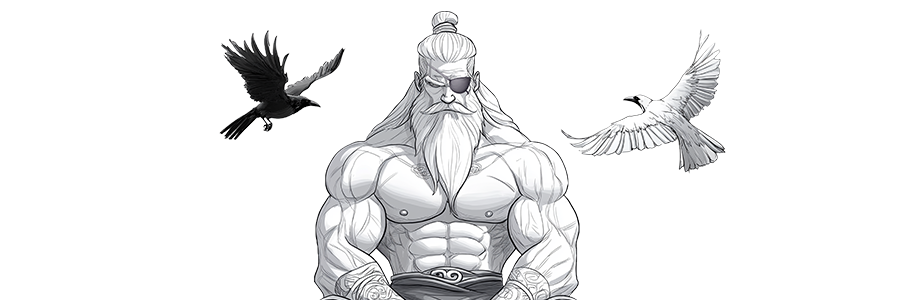

Among the Norse gods, none looms larger than Odin, the Allfather. Known as the god of wisdom, war, poetry, and the dead, Odin embodies the paradoxical nature of Norse religion: both noble and treacherous, wise and ruthless, divine and doomed. He is not a simple father figure but a restless seeker, sacrificing parts of himself to gain knowledge that even he cannot fully control.
This article explores Odin’s role in Norse mythology: his origins, attributes, myths, and cultural significance. Drawing on the Poetic Edda, the Prose Edda, and archaeological evidence, we will see how Odin represents both the ideals and anxieties of Viking Age society.
🦅 Embody Odin’s Wisdom — Odin Hoodie
👕 Odin T-shirt coming soon — full set upgrade awaits!
Odin is perhaps the most complex deity of the Norse pantheon. He is known by over 200 names in the sources, each emphasizing a different aspect of his power (Simek, 2007).
Allföðr (Allfather): Father of the gods and mankind.
Valföðr (Father of the Slain): Chooser of warriors who fall in battle.
Hrafnagud (Raven God): Associated with his two ravens, Huginn (Thought) and Muninn (Memory).
Bölverkr (Evil-doer): A reminder of his cunning and sometimes ruthless deeds.
His multiplicity reflects his role as a shape-shifter, wanderer, and god of contradictions.
Unlike many divine figures, Odin is defined by his relentless quest for wisdom. He is willing to endure pain, sacrifice, and deceit to gain knowledge that others cannot.
The Well of Mimir: Odin sacrifices one of his eyes at Mimir’s well to drink from the waters of wisdom (Völuspá, stanza 28).
The Runes: In Hávamál, Odin describes how he hanged himself on the World Tree, Yggdrasil, for nine nights, pierced by his own spear, in order to discover the runes — powerful symbols of knowledge and magic.
Seiðr (Sorcery): Odin is associated with seiðr, a form of shamanic magic often considered unmanly in Norse culture, yet central to his power.
This willingness to suffer and transgress boundaries makes Odin a figure of both awe and unease.
Odin is not only the god of wisdom but also the god of war and death. Unlike Thor, who represents straightforward strength, Odin’s warfare is strategic, psychological, and treacherous.
Valhalla: Odin selects warriors slain in battle to join him in Valhalla, where they prepare for Ragnarök.
The Valkyries: Female figures who choose the slain, acting on Odin’s behalf.
Fickle Loyalty: Odin is notorious for betraying his chosen warriors if it serves his purposes, a trait that reflects the uncertainty of fate in Norse belief (Lindow, 2001).
⚡ Channel Thor’s Strength — Thor Hoodie
👕 Thor Long Sleeve Available Here
One of Odin’s most celebrated myths is the theft of the Mead of Poetry. According to Skáldskaparmál, Odin tricked the giant Suttungr, seduced his daughter Gunnlöð, and stole the magical mead that granted the gift of poetry. Odin’s cunning ensured that poets (skalds) drew their inspiration from him, though some unlucky ones were said to receive only the dregs, producing poor verse (Faulkes, 1995).
This myth highlights Odin’s ambiguous nature: both benefactor and deceiver, elevating culture while practicing trickery.
Central to Odin’s identity is his relationship with fate (urðr). Though the Allfather seeks wisdom and power, he knows he cannot escape his destined death at Ragnarök.
He will fight the wolf Fenrir and be devoured.
His son Víðarr will avenge him, but Odin himself cannot survive.
This acceptance of fate, combined with the relentless attempt to resist it, reflects the tragic heroism at the heart of Norse religion.
🔥 Loki gear coming soon — stay tuned, trickster fans!
🌟 Baldr collection in development — purity meets power!
For Viking Age societies, Odin symbolized both aspiration and danger. Chieftains and poets often claimed descent from Odin, aligning themselves with his wisdom and authority. Warriors, however, might be more drawn to Thor, whose loyalty contrasted with Odin’s fickleness.
Archaeology confirms Odin’s importance: depictions of one-eyed figures on picture stones, runestones invoking him, and the persistence of “Odin names” in Scandinavian place-names all show his cultural impact (Price, 2020).
Odin’s influence extends far beyond the Viking Age. Romantic writers, nationalist movements, and modern media (from Wagner’s Ring Cycle to Neil Gaiman’s American Gods) have reimagined him as both divine patriarch and enigmatic wanderer.
For brands, sports, and modern aesthetics, Odin continues to embody wisdom, endurance, and visionary strength — qualities that resonate with those seeking meaning in challenge.
🦅 Embody Odin’s Wisdom — Odin Hoodie
Odin is not a god of comfort or simple morality. He is a god of contradictions — wise yet deceitful, generous yet cruel, doomed yet powerful. As the Allfather, he embodies the complexities of human striving: the hunger for knowledge, the acceptance of fate, and the pursuit of meaning in a world where even gods must die.
For the Norse, Odin was both guide and trickster, both inspiration and warning. For us today, he remains a symbol of relentless curiosity and endurance in the face of destiny.
Faulkes, Anthony. Edda. Everyman, 1995.
Larrington, Carolyne (trans.). The Poetic Edda. Oxford University Press, 2014.
Lindow, John. Norse Mythology: A Guide to the Gods, Heroes, Rituals, and Beliefs. Oxford University Press, 2001.
Price, Neil. Children of Ash and Elm: A History of the Vikings. Allen Lane, 2020.
Simek, Rudolf. Dictionary of Northern Mythology. Boydell & Brewer, 2007.